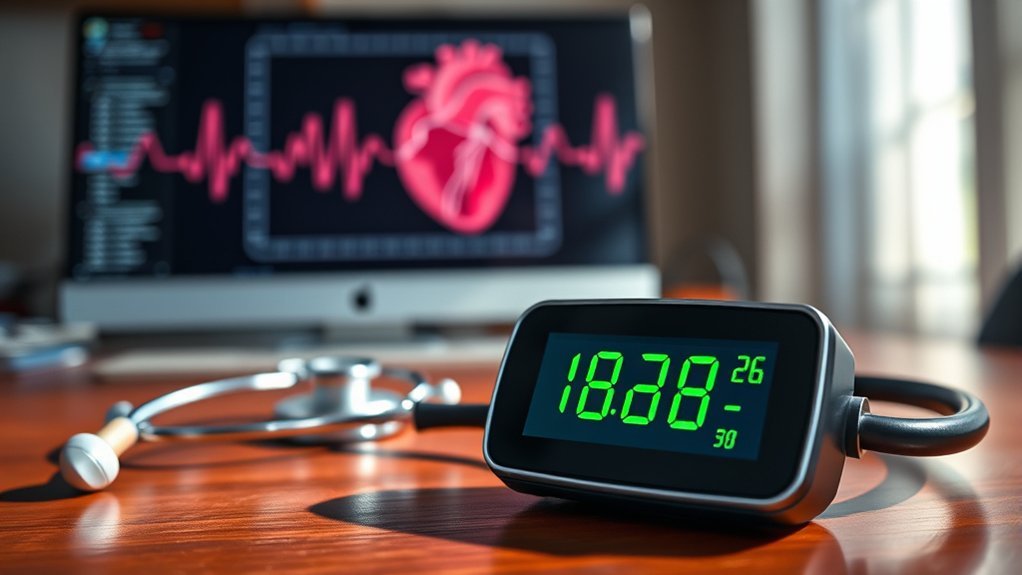When it comes to heart rate guidelines, it’s easy to get caught up in common myths that can steer you off course. Many people think a higher heart rate means better fat burning, but that’s not quite true. Understanding the real relationship between heart rate, fitness, and age is essential for optimizing your workouts. Are you ready to uncover the facts that can enhance your training approach and improve your overall health?
Understanding Normal Resting Heart Rate
When it comes to your heart, understanding your resting heart rate is essential for gauging your overall health. Your resting heart rate, typically measured in beats per minute (bpm), reflects your heart’s efficiency and fitness level.
For most adults, a normal resting heart rate ranges from 60 to 100 bpm. Factors like age, fitness level, and stress can influence this measurement. A lower resting heart rate often indicates better cardiovascular fitness, as your heart doesn’t have to work as hard when you’re at rest.
To find your resting heart rate, check it first thing in the morning before getting out of bed. Keeping track of this metric can help you monitor your health and fitness progress over time.
The Importance of Heart Rate Zones
Monitoring your resting heart rate is just the beginning of understanding your cardiovascular health. To maximize your fitness and performance, it’s essential to grasp heart rate zones.
Understanding your resting heart rate is just the first step; mastering heart rate zones is key to optimizing your fitness journey.
These zones help you tailor your workouts and achieve your goals. Here’s why they matter:
- Fat Burning: Exercising in the fat-burning zone boosts your metabolism and aids weight loss.
- Cardiovascular Endurance: The aerobic zone enhances your heart and lung capacity, leading to improved stamina.
- Anaerobic Performance: Training in the anaerobic zone increases strength and power, vital for high-intensity activities.
- Recovery: Monitoring your heart rate during recovery helps you gauge your fitness level and avoid overtraining.
Understanding these zones empowers you to train smarter, enhancing both your health and performance.
Debunking Common Heart Rate Myths
While many people believe certain myths about heart rate, understanding the facts can greatly improve your training outcomes.
One common myth is that a higher heart rate always means you’re burning more fat. In reality, fat oxidation is most efficient at moderate intensities.
Another misconception is that heart rate monitors are always accurate; factors like hydration and temperature can impact readings.
Many also think you should stick to a specific heart rate zone for ideal training, but varying your intensity can boost overall fitness.
Finally, some believe that heart rate slows down with age, but it’s more about fitness levels than age alone.
How to Monitor Your Heart Rate Effectively
How can you guarantee you’re tracking your heart rate accurately during workouts?
Monitoring your heart rate effectively is essential for optimizing your performance. Here are four reliable methods:
Effective heart rate monitoring is crucial for enhancing your workout performance. Explore reliable methods to track your heart rate accurately.
- Use a Heart Rate Monitor: Invest in a chest strap or wrist-based monitor for precise readings.
- Check Your Pulse: Manually measure your pulse at your wrist or neck for a quick check.
- Smartphone Apps: Utilize apps that use your camera to analyze your heart rate through your fingertip.
- Wear Fitness Trackers: Many fitness trackers continuously measure your heart rate, providing real-time data.
The Role of Heart Rate in Overall Fitness
Understanding your heart rate during workouts is just the beginning; it plays a significant role in your overall fitness journey. Your heart rate helps you gauge exercise intensity, ensuring you’re pushing yourself enough to gain benefits without overdoing it.
Training in different heart rate zones—like fat-burning or aerobic—targets specific fitness goals. For example, staying in the moderate zone can improve cardiovascular endurance, while higher intensities boost your anaerobic capacity.
Monitoring your heart rate can also prevent injury and fatigue, allowing for better recovery. By using this essential data, you can tailor your workouts, track progress, and stay motivated.
Ultimately, understanding your heart rate empowers you to make informed choices that enhance your fitness and well-being.
Frequently Asked Questions
Can Heart Rate Vary Significantly Between Individuals?
Yes, your heart rate can vary considerably from others due to factors like age, fitness level, and genetics. Understanding these differences helps you monitor your health effectively and tailor your fitness routine to your unique needs.
What Factors Can Temporarily Elevate Heart Rate?
When life throws you a curveball, your heart races! Factors like stress, caffeine, exercise, and excitement can temporarily elevate your heart rate. Understanding these influences helps you manage your body’s responses effectively.
Is It Safe to Exercise With a High Heart Rate?
Yes, it’s generally safe to exercise with a high heart rate, as long as you’re accustomed to the intensity. Listen to your body, stay hydrated, and consult a doctor if you have concerns about your health.
How Does Hydration Affect Heart Rate?
Hydration considerably affects your heart rate. When you’re dehydrated, your heart works harder to pump blood, leading to an increased heart rate. Staying well-hydrated keeps your heart functioning efficiently, especially during exercise or hot conditions.
Can Certain Medications Influence Heart Rate Readings?
Yes, certain medications can influence your heart rate readings. For instance, beta-blockers may lower your heart rate, while stimulants can increase it. Always consult your doctor about how your medications affect your cardiovascular health.
Conclusion
In the grand tapestry of fitness, understanding your heart rate is a thread that weaves it all together. By debunking myths and embracing facts, you’re not just chasing numbers; you’re revealing your body’s potential. So, whether you’re monitoring your resting rate or exploring heart rate zones, remember that knowledge is your best workout partner. Embrace these insights, and watch your fitness journey transform as you move toward a healthier, more informed you.
